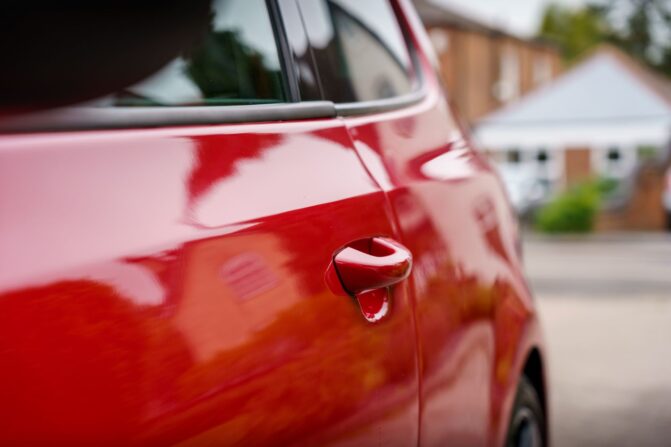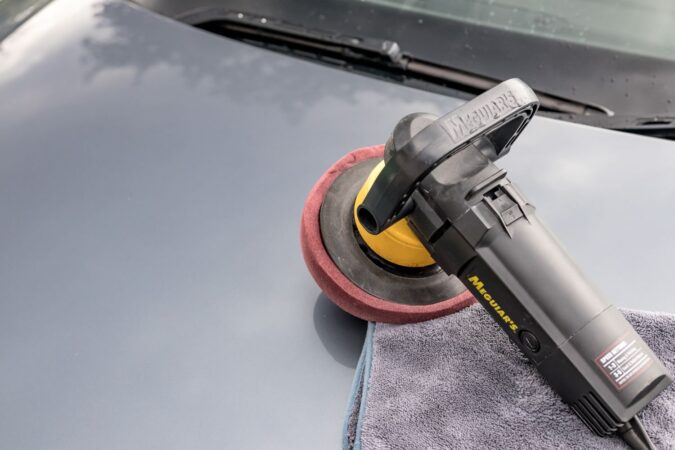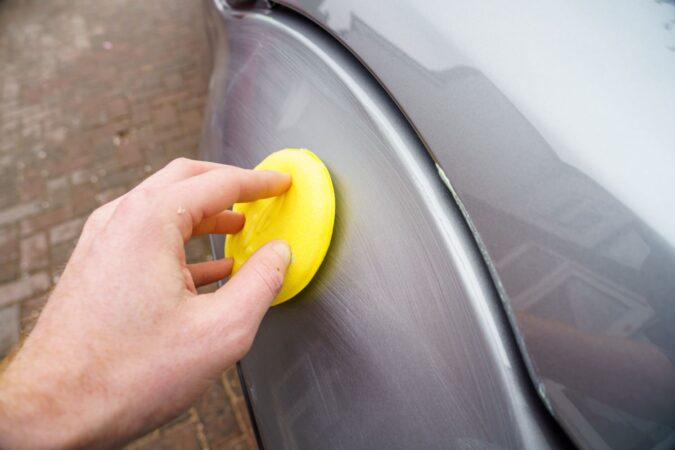Folks shopping around for a car at a dealership might sometimes notice that most of these cars come with something called ‘PermaPlate’ installed. Or, at the very least, it’s a dealership option that you could get for your car. It’s a pretty expensive piece of paint protection, so is PermaPlate really a form of ceramic coating? Plus, does it protect your car from scuffs or dents?
One thing to note is that PermaPlate isn’t a product type or category, but a brand name. As a company, PermaPlate specializes in automotive paint and surface protection, such as tires, windshields, bodywork, paintwork, and even theft! They even offer interior protection. Additionally, many car dealers work with PermaPlate to offer extra protection for your new car.
This usually adds an extra $600 or so on top of a car’s sticker price just to have PermaPlate installed. However, if you’re expecting PermaPlate to be a super-strong and durable layer of ceramic coating, the answer isn’t so straightforward. If anything, PermaPlate is more like a sealant than a ceramic coating, though it’s not really made clear. Here’s how they differ…
PermaPlate vs Ceramic Coating – How Do They Differ?
The first thing to bear in mind is how ceramic coating works. Ceramic coating is a chemical made from silica dioxide that you apply to a car’s body. This extra layer on top of your car’s paint will protect it from minor scuffs and dents. It protects the car from stone chips, scratches from improper washing, and sometimes, very minor scrapes from other cars.
Generally speaking, ceramic coating is one of the best forms of paint protection that you can get for your car. However, it’s also one of the more expensive alternatives. On the other hand, with PermaPlate, it’s hard to find data on whether it really is a ceramic coating or not. Neither their website nor car dealers specify that it’s a ceramic coating or if it’s just wax.
For all we know, based on what we could find, PermaPlate appears to just be a normal sealant. The latter doesn’t last nearly as long, nor is it as durable, as proper ceramic coating. Judging by the way it’s applied too, PermaPlate is most likely a polymer sealant. Regardless, is it even worth the hefty $600 premium when getting it installed at the car dealership?
Well, most car dealers charge $600 for PermaPlate protection for the interior, windshield, and paint protection, and there’s often a warranty attached. All in all, sounds like a good deal, right? Although, there’s a lot of skepticism about how much protection PermaPlate offers. Granted, it ought to offer at least a bit more protection than not having it installed at all.
What Other Types Of Paint Protection Are There?
So, what’s our recommendation on whether or not you should take up your car dealer’s offer to install PermaPlate? Well, if the dealer applies it for free, that’s great! We all like free things. And, it helps to protect your car. But if you have to pay extra, we recommend that you stay away from it. Instead, get protection later on from an auto detailer.
Personally, I find it hard to justify the $600 upcharge by the dealer just to have PermaPlate installed, which offers a sufficient level of protection, but not overwhelmingly so. Therefore, if you want to install aftermarket paint protection on your car from a professional auto detailer, here are some other good alternatives, instead (varying in costs and the protection they offer):
1. Wax
Wax is the simplest and cheapest protection for your car. However, it only prevents dirt and grime from sticking to the car’s paint. The benefit is that you don’t have to wash it very hard to clean it, and minimizes the chance of swirls and scratches from washing. However, typical car wax doesn’t protect your car from deep scratches and stone chips on the paint.
Another downside is that they last no more than three months. Depending on how you treat your car and how you wash it, it may last shorter than that. So, you’ll need to reapply them quite often. Still, this is a great—and cheap—option if you want to make your car look shiny and brand new while protecting it from dirt and grime. It costs between $60 to $150 on average.
You can go to an auto detailer or a car wash and get a wax job, so it’s relatively accessible. Note that the cost depends on the car size, so larger cars will likely be on the higher end of the spectrum. If you have the spare time, you could even apply car wax yourself. All you need is quality car wax such as from TurtleWax, clean microfiber towels, and an applicator pad.
2. Sealant
Sealant or paint sealant is a synthetic polymer that you apply onto the car’s surface. PermaPlate is quite similar to this. Professional detailers will apply it by using a polishing machine or an applicator pad. Once the chemical cures, it bonds with the paint surface and forms a protective layer on top of the car’s paint to protect it from dirt, scratches, and scuffs.
You’ll notice that they’re similar to ceramic coating, in the sense that they create a protective layer. Hence, the mass confusion with PermaPlate. However, the application method is different. And, ceramic coating is harder and more durable, meaning it lasts longer and offers better protection. That being said, sealant will offer enough protection for most scenarios.
Additionally, auto detailers often offer how many layers of sealant you want to apply to your car. Most will apply two layers as standard, but you’ll usually have the option to pay extra and apply up to five layers. There are virtually no benefits to applying more than five layers. Auto detailers will charge between $200 and $600 on average, though it varies by car size.
The cost usually already includes the cost of polishing, paint correction, and other prep work. As for durability, sealants will last anywhere between six months to a year. This depends on the quality of the product, and how many layers you apply. You can do this yourself to save money if you have a polishing machine, but this is a long and labor-intensive process.
3. Ceramic Coating
As noted earlier, ceramic coating is made from silica dioxide. Some auto detailers may also refer to it as glass or crystal coating. Additionally, some ceramic coating may use nanotechnology to improve its hydrophobic quality and UV resistance. Auto detailers will call it nano-coating or nano-ceramic coating, and the application is slightly different from sealants.
Instead of using a polishing machine, you’ll need to apply it by using an applicator pad and then rubbing it onto the surface in a crosshatch pattern. Almost like you’re painting the car with a brush. As you’d expect, it’s a long, complex, and labor-intensive process. So, if you don’t have the time or energy, it’s best to just go to an auto detailer and have them do it for you.
The average cost for a ceramic coating is usually between $1,000 to $3,000. Yes, that’s a lot of money, and it’s the biggest reason why folks are skeptical about PermaPlate. But, ceramic coating usually lasts at least a year, and some products may last for up to three years before you need to reapply them. Although, some maintenance is necessary to achieve this.
There’s also a hardness level for ceramic coating, signified with an ‘H’. This varies from 1H to 9H, and 9H is the hardest of them all. How long they last still depends on the product quality, but the harder they are, the better they are at resisting scratches and scuffs. In most cases, ceramic coating is one of the best forms of paint and surface protection you can get.
4. Paint Protection Film (PPF)
Paint Protection Film or PPF is a clear urethane wrap for your car. It’s the same sort of material as a sealant, but you apply it as a wrap rather than applying it in wax or fluid form like you would with a sealant. Almost as if you’re putting a sticker on your car. If you’ve seen a car with a brightly-colored wrap, PPF is almost similar to that in its application.
However, car wraps are vinyl, whereas PPF is urethane. The advantage of PPF is that some of them have self-healing properties, where you can remove scratches by simply applying heat. PPF is quite expensive, they can be anywhere between $900 to $2,000 depending on your vehicle’s size. However, this cost usually already includes the cost of detailing your car.
The upside is that they can have a very long service life. Some brands will claim up to five or even seven years. But we think a more realistic estimate is around three years. Still, three years is a long period. Another benefit is that they require very little maintenance. Sealants and ceramic coatings will require maintenance spray at least every few months.
On the flip side, this isn’t necessary with PPF, although proper washing and waxing every three months are recommended if you want to keep it looking new and shiny. The biggest downside of PPF is that it can be prone to yellowing over time. Especially if you often leave your car under the sun, though this thankfully won’t affect the paint underneath it.
5. Nano Graphene Coating
Emerging onto the auto protection scene is nano-graphene coating, a newcomer. Made from carbon-based nano-structures, graphene coatings are believed to surpass even the protective qualities of ceramic coatings (this is also reflected in its price). This new entrant is known for its exceptional hydrophobic properties, leading to excellent water beading.
Furthermore, due to its tight-knit structure, the nano-graphene coating offers excellent resistance against chemical contaminants, UV rays, and even minor scratches. The distinct feature of this coating is its capability to dissipate heat quickly. This means on hot days, the car’s paint will remain relatively cooler. Applying it is similar to applying ceramic coatings.
Now, while it might be tempting to try a DIY project, for maximum benefit and assurance, a professional touch is recommended. Price-wise, it might be similar to, or a tad more expensive than ceramic coatings, ranging from $1,200 to $3,500. Though costly, its longevity and resistance could justify the investment, promising protection for three to five years.
6. Hybrid Wax Coatings
A fusion of traditional car wax and modern sealants, hybrid wax coatings blend the best of both worlds. They offer the depth and warmth of a wax shine with the longevity and resilience of synthetic sealants (since PermaPlate is not a ceramic coating). These hybrid coatings have become popular recently as they tend to be easier to apply than more advanced products.
Yet, they still offer solid protection against common contaminants, minor scratches, and UV radiation. While they might not last as long as pure sealants or ceramic coatings, you can expect about 6-12 months of protection. Prices can vary based on product quality, but a high-grade hybrid wax-coating product will typically set you back just $20-$70.



